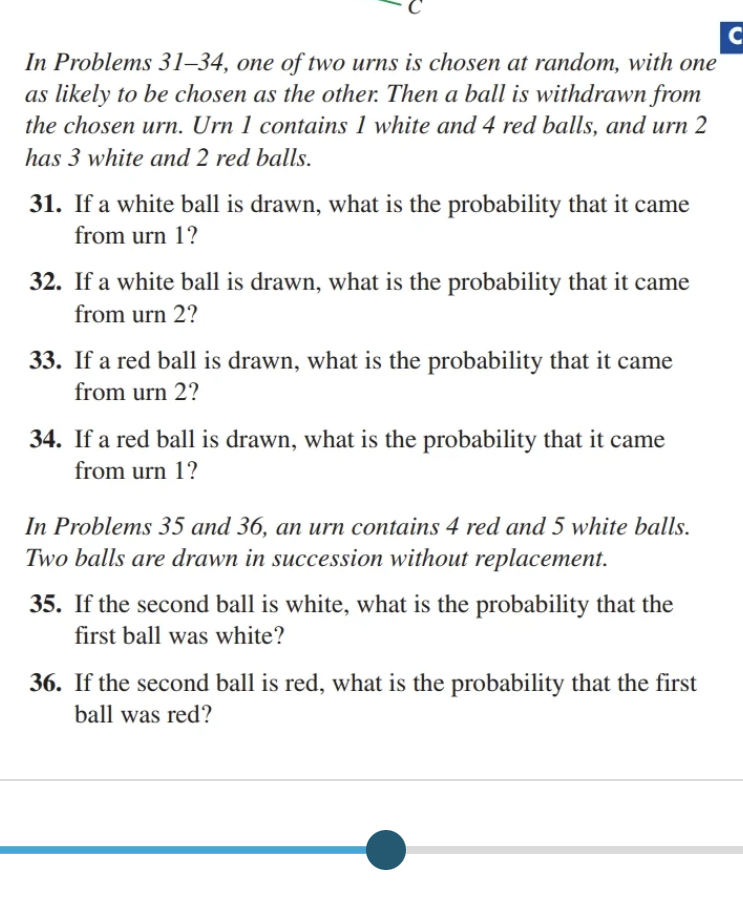C In Problems 31-34, one of two urns is chosen at random, with one as likely to be chosen as the other. Then a ball is withdrawn from the chosen urn. Urn 1 contains 1 white and 4 red balls, and urn 2 has 3 white and 2 red balls. 31. If a white ball is drawn, what is the probability that it came from urn 1? 32. If a white ball is drawn, what is the probability that it came from urn 2? 33. If a red ball is drawn, what is the probability that it came from urn 2? 34. If a red ball is drawn, what is the probability that it came from urn 1?
C In Problems 31-34, one of two urns is chosen at random, with one as likely to be chosen as the other. Then a ball is withdrawn from the chosen urn. Urn 1 contains 1 white and 4 red balls, and urn 2 has 3 white and 2 red balls. 31. If a white ball is drawn, what is the probability that it came from urn 1? 32. If a white ball is drawn, what is the probability that it came from urn 2? 33. If a red ball is drawn, what is the probability that it came from urn 2? 34. If a red ball is drawn, what is the probability that it came from urn 1?
A First Course in Probability (10th Edition)
10th Edition
ISBN:9780134753119
Author:Sheldon Ross
Publisher:Sheldon Ross
Chapter1: Combinatorial Analysis
Section: Chapter Questions
Problem 1.1P: a. How many different 7-place license plates are possible if the first 2 places are for letters and...
Related questions
Question
please help with 32

Transcribed Image Text:C
In Problems 31-34, one of two urns is chosen at random, with one
as likely to be chosen as the other. Then a ball is withdrawn from
the chosen urn. Urn 1 contains 1 white and 4 red balls, and urn 2
has 3 white and 2 red balls.
31. If a white ball is drawn, what is the probability that it came
from urn 1?
32. If a white ball is drawn, what is the probability that it came
from urn 2?
33. If a red ball is drawn, what is the probability that it came
from urn 2?
34. If a red ball is drawn, what is the probability that it came
from urn 1?
In Problems 35 and 36, an urn contains 4 red and 5 white balls.
Two balls are drawn in succession without replacement.
35. If the second ball is white, what is the probability that the
first ball was white?
36. If the second ball is red, what is the probability that the first
ball was red?
Expert Solution
This question has been solved!
Explore an expertly crafted, step-by-step solution for a thorough understanding of key concepts.
This is a popular solution!
Trending now
This is a popular solution!
Step by step
Solved in 2 steps with 2 images

Recommended textbooks for you

A First Course in Probability (10th Edition)
Probability
ISBN:
9780134753119
Author:
Sheldon Ross
Publisher:
PEARSON


A First Course in Probability (10th Edition)
Probability
ISBN:
9780134753119
Author:
Sheldon Ross
Publisher:
PEARSON
